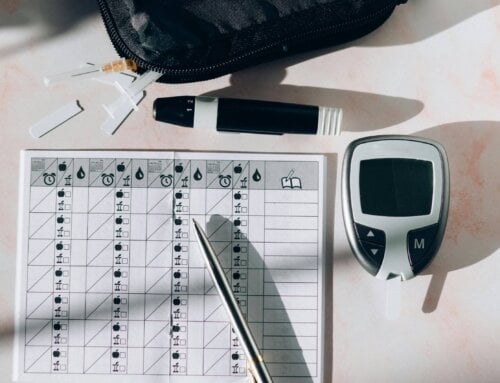People with diabetes face the stress of constantly managing the condition and the risk of related health issues. Meditation can help diabetes by reducing stress, lowering blood sugar levels and minimizing the risk of cardiovascular disease. Find out how taking some quiet time to meditate can help people manage diabetes and achieve improved overall well-being.
Meditation is a Timeless Technique
Meditation is thousands of years old and still practiced today by people of different cultures all around the globe. In a non-stop world, meditation involves taking 10-20 minutes each day to focus quietly on your breathing. There is a myriad of physical and mental benefits associated with meditating.
What is Meditation?
Meditation is used to bring people to a more peaceful state of mind. No special equipment is required. All a person needs are focus and practice to reach a meditative state of mind. Usually, the focus is on breathing techniques and/or the use of a single focus word. These techniques have been shown to relieve stress, lower blood pressure and reduce chronic or acute pain. There is a wealth of physical and mental benefits associated with meditating. It is beneficial for those looking to achieve calmness of body and mind. No major lifestyle changes are required to practice meditation. It is simply a tool that requires devoted time and constant practice. People may be able to better manage blood sugars and diabetes when they practice meditation.
Basic Types of Meditation
There are various types of meditation. These include mindfulness, transcendental, and focused awareness meditation. They are all done differently with the same goal of focusing to reduce mental and physical stresses. Beginners can start meditating for 10 minutes and slowly work up to doing it for 20 minutes at a time. Plan a specific time of day for meditation. Some people like to start the day with a still calmness and others prefer to wind down with meditation at the end of the day. Decide which time works better for you by experimenting.
More about Forms of Meditation
Mindfulness meditation focuses on your breathing to achieve awareness in-the-moment. During transcendental, a word called a mantra is repeated in the person’s mind or out loud to help improve focus. During focused awareness, the person stares at an object with half-open eyes while focusing on breathing. Often a candle is an object used during this type of meditation. Most people sit comfortably on the floor during this time, but it can also be done while lying down, sitting in a chair or standing. People can meditate alone, with a group, privately or in public. Some prefer to meditate outdoors in a park or other quiet area. Most people prefer to wear comfortable, loose-fitting clothing while meditating.

Awareness and Mindfulness Meditation
Mindfulness meditation is focused on concentrated awareness to live every moment to its fullest. This is done by developing awareness in your life and an accepting open attitude. This perspective can help people manage diabetes, respond thoughtfully during challenging times, and live more fully.
The Benefits of Mindfulness Meditation
Mindfulness meditation helps reduce stress levels and lowers blood pressure. It also reduces the levels of stress hormones in your body such as epinephrine, cortisol, and norepinephrine. Some of these hormones also contribute to weight gain, insulin resistance, and belly fat which can boost your risk of heart problems, high blood pressure and uncontrolled diabetes. Research presented at an American Diabetes Association Conference stated “mindfulness meditation could be helpful for people with diabetes”. This level of quiet contemplation helps people alleviate their worries and fears about the past and future. Breathing brings people into the present moment and quiets their minds. This can also minimize the anxiety and depression frequently associated with diabetes. This type of meditation is often done while sitting with your back straight, either in a chair on the floor. The process starts by focusing on your breathing. People learn to become objective observers who can minimize distractions such as odors, light, sounds, and thoughts. People learn to be calm in the present moment. As a result, people can learn from the past and let it go. People can practice these techniques with guidance from tapes, books, and CDs. Classes may also be offered at community centers, libraries, schools, clinics, hospitals, and some houses of worship.
The Restfulness of Transcendental Meditation
During transcendental meditation, people achieve a feeling of restfulness. Many compare these 10-20 minutes to taking a nap for an hour or two. This can be refreshing for people with diabetes who often experience bouts of fatigue.
Learning Transcendental Meditation
Transcendental meditation can also be learned through the use of classes and reference materials. Some people also seek out formal training from a specialist. To start, a mantra is created that is repeated over and over to calm the mind. The universal mantra is, “Ohm”. Usually, a mantra is one syllable but it can also be a phrase. Then the person sits with closed eyes and a straight spine to repeat the mantra for 10 minutes. Over a few weeks, the time can be increased to 15 then 20 minutes. It is helpful to try to meditate at the same time of day. Some people fall asleep or daydream when meditating. It can help to set a timer to indicate when the time is up and focus on your mantra to avoid daydreaming. A study in the Archives of Internal Medicine stated, “transcendental meditation could help people with diabetes control their blood glucose levels, reduce insulin resistance, and lower blood pressure”.
Stress, Meditation, and Diabetes
The constant self-management of diabetes and fluctuating blood sugar levels can cause stress. Meditating can help people reduce stress and learn how to handle stressful situations without getting worried or upset. This will impact blood sugars.
Relaxation Makes a Difference

Reduction of Pain
An added benefit of meditating is relief from chronic pain. Often people with diabetes experience nerve pain called neuropathy or discomfort. Meditating can reduce pain without potentially harmful side effects.
The Connection between Pain and Overall Health
When people with diabetes experience nerve pain, it can boost their stress and anxiety levels. This also means their blood sugar levels might be raised. The relief of chronic pain through meditating can help reduce these health problems and lower blood pressure rates. Use blood pressure cuffs and a blood glucose meter to monitor your progress. You are likely to see your rates go down as a result of continued meditation with the added benefit of feeling less pain. Meditation can also help reduce the inflammation associated with diabetes. Meditating can also help reduce headaches and insomnia commonly associated with ongoing pain.
Meditation is another way to help you manage diabetes and the symptoms associated with this condition. With ongoing practice and focus, meditation can help you reduce stress, lower your blood pressure, and maintain better blood glucose control. All you need to do is breathe!












Leave A Comment